|
|
|
|
|
|
|
|
Visit India |
|
|
|
|
|
|
Kailash Manasarovar Yatra |
|
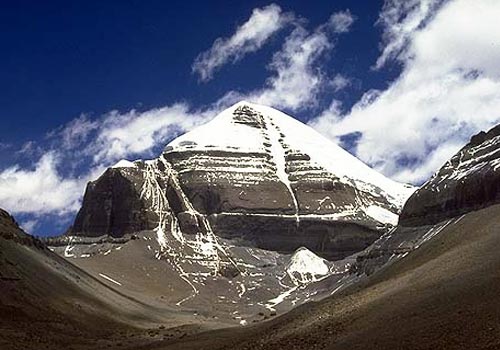 It gives us divine pleasure in facilitating the pilgrimage of the all-faithful “Shiv-Bhakts” to the Mother of all “Tirtha Sthaan” - Kailash Manas Sarovar. Mount Kailash is one of the world’s most sacred spots. It gives us divine pleasure in facilitating the pilgrimage of the all-faithful “Shiv-Bhakts” to the Mother of all “Tirtha Sthaan” - Kailash Manas Sarovar. Mount Kailash is one of the world’s most sacred spots.
To experience its spiritual energy you must go there but with the right intention in mind. The Kailash Mansarovar Yatra, is a pilgrimage and the intent should be to visit it for peace, both within each person and then the world. Tibetans leave an article of clothing or a drop of blood, hair or a stone to symbolize leaving their prejudices behind them. One should leave their ego, anxiety and meanness here.
|
|
|
Mata Vaishno Devi - Katra |
|
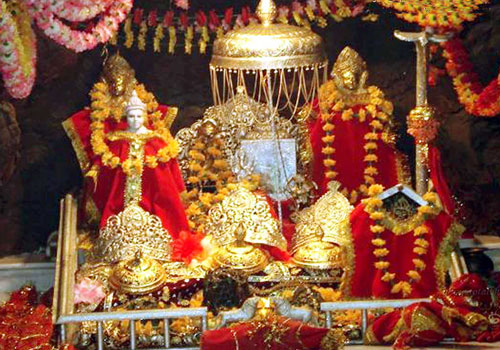 The town of Katra, which is close to Jammu, contains the Vaishno Devi shrine. Nestling on top of the Trikuta Hills at a height of 1700 m is the sacred cave shrine of Vaishno Devi, the mother goddess. The town of Katra, which is close to Jammu, contains the Vaishno Devi shrine. Nestling on top of the Trikuta Hills at a height of 1700 m is the sacred cave shrine of Vaishno Devi, the mother goddess.
At a distance of 48 km from Jammu, the cave is 30 m long and just 1.5 m high. At the end of the cave are shrines dedicated to the three forms of the mother goddess—Mahakali, Mahalakshmi and Mahasarasvati.
Pilgrims start trekking to the cave temple, which is 13 km from Katra, enter in small groups through a narrow opening and walk through ice-cold waters to reach the shrines.
According to legend, the mother goddess hid in the cave while escaping a demon whom she ultimately killed.
|
|
|
Baba Amarnath - Kashmir |
|
 Amarnath Yatra in India is dedicated to Lord Shiva, one of the Trinity gods. The Amarnath shrine is located approximately 145 km from Srinagar, 4,175 m above sea level. The path leading to the holy cave of Amarnathji is inaccessible in the winters. Amarnath Yatra in India is dedicated to Lord Shiva, one of the Trinity gods. The Amarnath shrine is located approximately 145 km from Srinagar, 4,175 m above sea level. The path leading to the holy cave of Amarnathji is inaccessible in the winters.
This is because from September to June, the weather conditions in the area are extremely hostile and the path remains covered with snow. The Amar Nath pilgrimage tour from Kashmir is possible only in monsoons, i.e. from July to August. The Amarnath Yatra holds great significance for the devotees, especially of Lord Shiva. |
|
|
Sai Baba - Shirdi |
|
 122 kms from Nashik is the abode of one of Maharashtra's most revered saint -- Sai Baba of Shirdi. Popularly known as the 'Child of God', Sai Baba preached tolerance towards all religions and the message of universal brotherhood. 122 kms from Nashik is the abode of one of Maharashtra's most revered saint -- Sai Baba of Shirdi. Popularly known as the 'Child of God', Sai Baba preached tolerance towards all religions and the message of universal brotherhood.
Every activity at Shirdi revolves around the vast temple complex dedicated to Sai Baba. Devotees start queuing up in the early hours of dawn to catch a glimpse and seek the blessings of the life-size statue of Sai Baba. Thursday is marked by special pujas and darshan of the Sai Baba statue. There are other places of interest that devotees can visit as well including Dwarkamani Mosque where the Baba meditated and slept on alternate nights. Near the mosque, in a corridor is the dhuni or eternal flame that burns day and night. Other places of importance are the Gurusthan, the Kandoba Temple, Shani Mandir, Narsimha Mandir, Changdev Maharaj Samadhi and the Sakori Ashram. |
|
|
Jagannath Puri - Orissa |
|
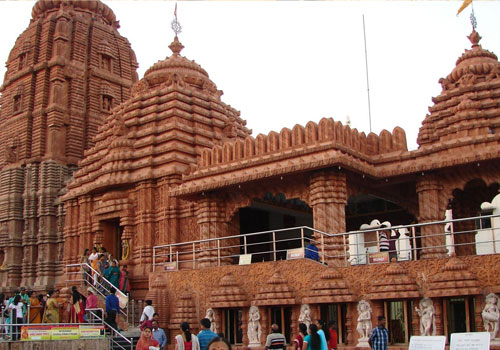 Shri Shri Jagannath Mahaprabhu lord of the Universe is the supreme solace and saviour of countless devotees around the world. since time immemorial, His monumental and magnificent Shrine at Shri Purusottam-Kshetra (Puri, Orissa) one of the four major Dhamas of India has been a most sacred centre of pilgrimage and worship symbolising and uploading one of the greatest spiritual and cultural heritages of the world. Shri Shri Jagannath Mahaprabhu lord of the Universe is the supreme solace and saviour of countless devotees around the world. since time immemorial, His monumental and magnificent Shrine at Shri Purusottam-Kshetra (Puri, Orissa) one of the four major Dhamas of India has been a most sacred centre of pilgrimage and worship symbolising and uploading one of the greatest spiritual and cultural heritages of the world.
The most frrequently depicted theme involves the holy Triad of the Jagannath Temple - Lord Jagannath, Balabhadra and Subhadra |
|
|
Kedarnath ji - Utrakhand |
|
 Kedarnath Temple is one of the holiest Hindu temples dedicated to the god Shiva and is located on the Garhwal Himalayan range near the Mandakini river in Kedarnath, Uttarakhand in India. Due to extreme weather conditions, the temple is open only between the end of April (Akshaya Tritriya) to Kartik Purnima (the autumn full moon, usually November) every year. During the winters, the vigrahas (deities) from Kedarnath temple are brought to Ukhimath and worshipped there for six months. Lord Shiva is worshipped as Kedarnath, the 'Lord of Kedar Khand', the historical name of the region. Kedarnath Temple is one of the holiest Hindu temples dedicated to the god Shiva and is located on the Garhwal Himalayan range near the Mandakini river in Kedarnath, Uttarakhand in India. Due to extreme weather conditions, the temple is open only between the end of April (Akshaya Tritriya) to Kartik Purnima (the autumn full moon, usually November) every year. During the winters, the vigrahas (deities) from Kedarnath temple are brought to Ukhimath and worshipped there for six months. Lord Shiva is worshipped as Kedarnath, the 'Lord of Kedar Khand', the historical name of the region.
The temple is not directly accessible by road and has to be reached by a 14 kilometres (8.7 mi) uphill trek from Gaurikund. Pony and manchan service is also available. The temple is believed to have been built by Pandavas and revived by Adi Sankaracharya and is one of the twelve Jyotirlingas, the holiest Hindu shrines of Shiva. Pandavas were supposed to have pleased Shiva by doing penance in Kedarnath. The temple is also one of the four major sites in India's Chota Char Dham pilgrimage of Northern Himalayas. |
|
| Tirupati - Andhra Pradesh |
|
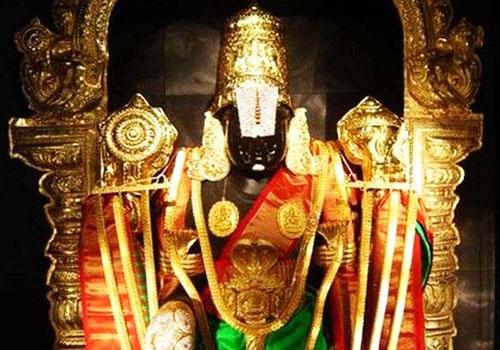 The world famous Tirumala Temple is located in the hill town of Tirumala in Tirupati, Chittoor District. Tirupati is famous for Sri Venkateswara Swamy temple dedicated to Lord Venkateswara. The world famous Tirumala Temple is located in the hill town of Tirumala in Tirupati, Chittoor District. Tirupati is famous for Sri Venkateswara Swamy temple dedicated to Lord Venkateswara.
It is around 600 km (370 mi) from Hyderabad, 138 km (86 mi) from Chennai and 291 km (181 mi) from Bangalore.
Tiru means 'Holy' or 'Sacred' and mala means hills/mountain in Dravidian languages. Therefore it translates as Holy mountains.
The Tirumala Hill is 853m above sea level and is about 10.33 square miles (27 km2) in area. It comprises seven peaks, representing the seven heads of Adisesha, thus earning the name Seshachalam. The seven peaks are called Seshadri, Neeladri, Garudadri, Anjanadri, Vrushabhadri, Narayanadri, and Venkatadri. The temple is on Venkatadri (also known as Venkatachala or Venkata Hill), the seventh peak, and is also known as the "Temple of Seven Hills". The presiding deity of the temple is Lord Venkateswara, a form of the Hindu god Vishnu. Venkateswara is known by other names: Balaji, Govinda, and Srinivasa. The temple lies on the southern banks of Sri Swami Pushkarini, a holy water tank. The temple complex comprises a traditional temple building, with a number of modern queue aand pilgrim lodging sites.
The temple is the richest pilgrimage center, after the Sree Padmanabhaswamy Temple in Thiruvananthapuram, Kerala, of any faith (at more than INR 50,000 crore) and the most-visited place of worship in the world. The temple is visited by about 50,000 to 100,000 pilgrims daily (30 to 40 million people annually on average), while on special occasions and festivals, like the annual Brahmotsavam, the number of pilgrims shoots up to 500,000, making it the most-visited holy place in the world.
There are several legends associated with the manifestation of the Lord in Tirumala. According to one legend, the temple has a murti (deity) of Lord Venkateswara, which it is believed shall remain here for the entire duration of the present Kali Yuga. |
|
|
Somnath Temple - Gujarat |
|
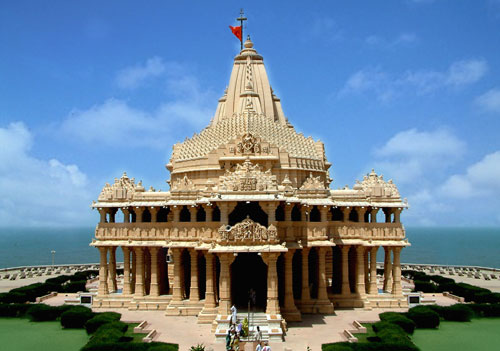 The Somnath
Temple
located
in the Prabhas
Kshetra near
Veraval in
Saurashtra, on
the western
coast of
Gujarat, India,
is one of the
twelve
Jyotirlinga
shrines of the
god Shiva.
Somnath means
"The Protector
of (the) Moon
god". The
Somnath Temple
is known as "the
Shrine Eternal",
having been
destroyed many
times by Islamic
kings and
rulers. The Somnath
Temple
located
in the Prabhas
Kshetra near
Veraval in
Saurashtra, on
the western
coast of
Gujarat, India,
is one of the
twelve
Jyotirlinga
shrines of the
god Shiva.
Somnath means
"The Protector
of (the) Moon
god". The
Somnath Temple
is known as "the
Shrine Eternal",
having been
destroyed many
times by Islamic
kings and
rulers.
According to legend, Soma, the moon God built the temple in gold, Ravan in silver, Krishna in wood and king Bhimdev of Anhilwad in stone. Soma constructed the temple as a gesture after Lord Shiva cured him of his illness. This illness was caused by his father-in-law Daksha Prajapati's curse.
The beautiful statue of Somanath, can be seen from the center because of the miraculous magnetic power. Ghajni Mohammed, destroyed this statue on Friday, the 11th of May 1025 AD. From then onwards, Ghajni Mohammed came to be known as the “Statute Destroyer” (Iconoclast). On that day, he plundered and looted a treasure worth 18 crores.
|
|
|
|
Buddhist
Pilgrimages |
|
|
|
Bodhgaya - Bihar |
|
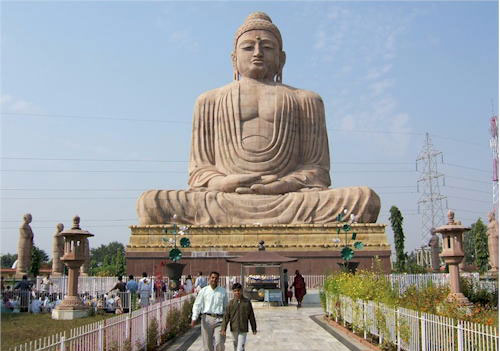 A place where Lord Buddha left his foot steps nearly 2500 years ago while travelling in the quest of enlightenment, situated by the river Phalgu, Bodhgaya is one of the most important and sacred Buddhist pilgrimage center in the world. It was here under a banyan tree, the Bodhi Tree, Gautama attained supreme knowledge to become Buddha,the Enlightened One. The serenity of the atmosphere remains in the subconscious soul of any visitor who takes the village as a pilgrimage that the Lord himself had chosen for meditation. A place where Lord Buddha left his foot steps nearly 2500 years ago while travelling in the quest of enlightenment, situated by the river Phalgu, Bodhgaya is one of the most important and sacred Buddhist pilgrimage center in the world. It was here under a banyan tree, the Bodhi Tree, Gautama attained supreme knowledge to become Buddha,the Enlightened One. The serenity of the atmosphere remains in the subconscious soul of any visitor who takes the village as a pilgrimage that the Lord himself had chosen for meditation.
There is a magnificent Mahabodhi temple and the Tree from the original sapling still stands in the temple premises. The temple is an architectural amalgamation of many centuries, cultures and heritages. While its architecture has a distinct stamp of the Gupta era, it has later ages inscriptions describing visits of pilgrims from Sri Lanka, Myanmar and China between 7th and 10th century AD. It is perhaps still the same temple Hieuen Tsang visited in 7th century. |
|
|
|
Sarnath - Varanasi
|
|
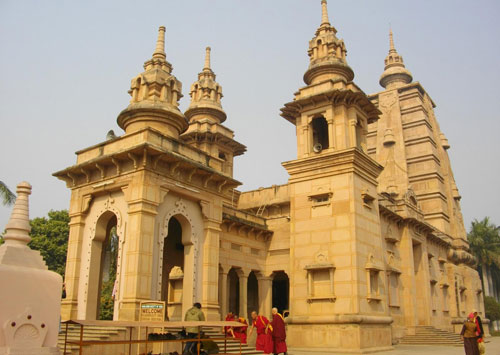 At a distance of only 10-km from the famous Hindu pilgrimage Varanasi, after attaining Enlightenment the Buddha went to Sarnath.
Lord Buddha had visited Sarnath looking for his five companions who abandoned him in Rajgir while they deviated from the viewpoint of Lord Buddha on self-mortification. At a distance of only 10-km from the famous Hindu pilgrimage Varanasi, after attaining Enlightenment the Buddha went to Sarnath.
Lord Buddha had visited Sarnath looking for his five companions who abandoned him in Rajgir while they deviated from the viewpoint of Lord Buddha on self-mortification.
Here in the Deer Park, he delivered his first sermon, set in motion the Wheel of Law (Maha-Dharmachakra Pravartan). The Emperor Ashoka (c 304 - 232 BC), who spread the Buddha's message of love and compassion throughout his vast empire, visited Sarnath around 234 BC, and erected a stupa here. Several Buddhist structures were raised at Sarnath between the 3rd century BC and the 11th century AD, and today it presents the most expansive ruins amongst places on the Buddhist trail. The ruins, the museum and temple are all within walking distance. |
|
|
Kushinagar - Uttar Pradesh |
|
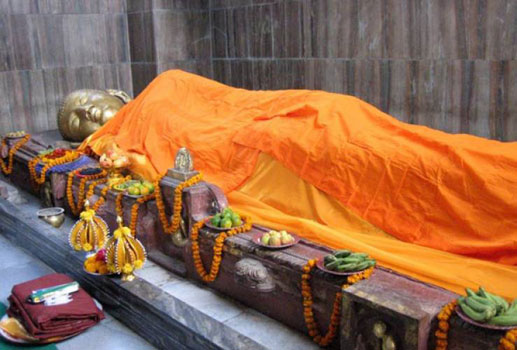 Kushinagar is another principal centre of Buddhism, worth a sincere admiration, is the place where Lord Buddha passed away at this place near the Hiranyavati River and was cremated at the Ramabhar stupa. It was once a celebrated center of the Malla kingdom. Many of its stupas and viharas date back to 230 BC-AD 413. when its prosperity was at the peak. In 543 BC, on a full moon night of Magh the legend delivered lecture to his Sangha and declared that he is going to leave the mortal world soon enough. Kushinagar is another principal centre of Buddhism, worth a sincere admiration, is the place where Lord Buddha passed away at this place near the Hiranyavati River and was cremated at the Ramabhar stupa. It was once a celebrated center of the Malla kingdom. Many of its stupas and viharas date back to 230 BC-AD 413. when its prosperity was at the peak. In 543 BC, on a full moon night of Magh the legend delivered lecture to his Sangha and declared that he is going to leave the mortal world soon enough.
The excavations led by general Cunningham has revealed some antique artifacts and structures related to all sects of Buddhism. Kushinagar also expresses the common thread of all sects of Buddhism through its magnificent Viharas, Chaityas, temples and Tibetan monasteries. In ancient times, the town was also known as Kushinara and Kasia. |
|
|
|
|
|
Scroll
|
|
|
|
 |
|
|
